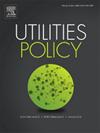伊朗配电系统运营商基于标准的企业架构:比较评估
IF 4.4
3区 经济学
Q3 ENERGY & FUELS
引用次数: 0
摘要
数字化转型和智能电网需求的对接要求配电系统运营商(dso)必须采用标准化的企业架构(EA)。基于对39个伊朗dso过程模型的回顾,本研究考察了两个框架:通用领域的美国生产力和质量中心(APQC)和特定领域的IEC 61968-1:2020,以评估它们在EA的业务、信息、软件和技术层上的适应性。研究结果表明,虽然APQC提供了业务流程的分类,但它没有为数据流、软件系统和技术建模,因此需要在dso中进行广泛的定制以适应。相比之下,IEC为dso提供了一个软件架构,为数据和任务流提供了一个精确的模型,为实现提供了最小的定制。本文章由计算机程序翻译,如有差异,请以英文原文为准。
Standards-based enterprise architecture for Iran's distribution system operators: A comparative assessment
The interfacing with digital transformation and smart grid requirements necessitates a standardized Enterprise Architecture (EA) in Distribution System Operators (DSOs). Based on a review of process models from 39 Iranian DSOs, this study examines two frameworks: the general-domain American Productivity and Quality Center (APQC) and the domain-specific IEC 61968–1:2020, to assess their adaptation across the business, information, software, and technology layers of EA. The findings show that while APQC provides the classification of business processes, it does not model data flows, software systems, and technologies, thus requiring extensive customization for adaptation in DSOs. In contrast, IEC, which presents a software architecture for DSOs, offers a precise model for the flow of data and tasks, facilitating minimal customization for implementation.
求助全文
通过发布文献求助,成功后即可免费获取论文全文。
去求助
来源期刊

Utilities Policy
ENERGY & FUELS-ENVIRONMENTAL SCIENCES
CiteScore
6.80
自引率
10.00%
发文量
94
审稿时长
66 days
期刊介绍:
Utilities Policy is deliberately international, interdisciplinary, and intersectoral. Articles address utility trends and issues in both developed and developing economies. Authors and reviewers come from various disciplines, including economics, political science, sociology, law, finance, accounting, management, and engineering. Areas of focus include the utility and network industries providing essential electricity, natural gas, water and wastewater, solid waste, communications, broadband, postal, and public transportation services.
Utilities Policy invites submissions that apply various quantitative and qualitative methods. Contributions are welcome from both established and emerging scholars as well as accomplished practitioners. Interdisciplinary, comparative, and applied works are encouraged. Submissions to the journal should have a clear focus on governance, performance, and/or analysis of public utilities with an aim toward informing the policymaking process and providing recommendations as appropriate. Relevant topics and issues include but are not limited to industry structures and ownership, market design and dynamics, economic development, resource planning, system modeling, accounting and finance, infrastructure investment, supply and demand efficiency, strategic management and productivity, network operations and integration, supply chains, adaptation and flexibility, service-quality standards, benchmarking and metrics, benefit-cost analysis, behavior and incentives, pricing and demand response, economic and environmental regulation, regulatory performance and impact, restructuring and deregulation, and policy institutions.
 求助内容:
求助内容: 应助结果提醒方式:
应助结果提醒方式:


